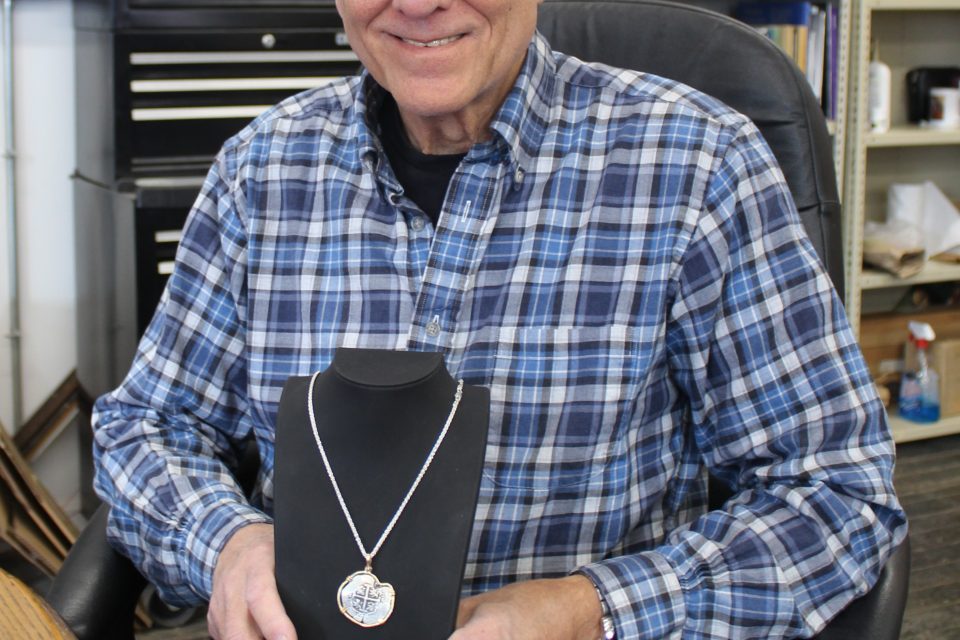AMESBURY – On the second floor of CI Works, which houses dozens of small manufacturing firms, Charles Doyle can be found in a well-lit room, surrounded by history books and strange-looking machines, replicating ancient coins from Biblical, Roman and Greek times.
A new addition to Coin Relicas Corps.’ offerings are copies of Spanish coins retrieved from the wreck off Cape Cod of a pirate ship. The ship had hauled Africans as slaves to the New World.
Doyle, who learned from his uncle how to make exact replicas of ancient coins, has been asked by the Whydah Pirate Museum in West Falmouth to produce replicas of three Spanish coins found in the Whydah Gally wreck.
The museum does not sell the artifacts found in the wreck, but visitors will be able to purchase Doyle’s replicas of coins that pirates risked their lives for.
Of the real coins he uses to create the replicas, Doyle said, “It’s really cool to hold a coin that a pirate once held.”
On April 26, 1717, the Whydah Gally, a large, well-armed ship with a crew of 146 pirates that included freed slaves led a small fleet up the Atlantic coast to Cape Cod.
The Whydah, built in London in 1715, as a slave ship, had already made two trans-Atlantic, voyages under veteran slave trader Lawrence Prince, when it was captured by pirates.
Samuel “Black Sam” Bellamy, thought to be the wealthiest pirate working the Caribbean Sea, converted the fast Whydah into his flagship. Bellamy pirated with Ben Hornigold, Henry Jennings, Oliver Le Vasseur and Edward (Blackbeard) Teach in what historians call the Golden Age of Pirating.
The Whydah was laden with treasures captured from dozens of Dutch, English, French and Spanish merchant ships. Originally from Massachusetts, Bellamy was headed home to Cape Cod where Maria Hallett, the love of his life, was waiting for him.
Tragedy struck when one of the most severe “nor’easters” in New England history capsized the Whydah. Only two of the crew survived.
The ship sunk off Wellfleet in 30 feet of water almost 2,000 feet from shore.
Despite efforts, shortly after by Colonial Gov. Samuel Shute to recover the treasures buried inside the Whydah, most of Bellamy’s cargo, including chests full of Spanish coins, lay off Cape Cod until 1984.
Underwater archaeological explorer Barry Clifford and his team found the wreck and began off-loading its treasures. They brought up cannons and pistols, buttons and buckles and lots of treasure – gold, silver and pieces of eight.
Much of the retrieved items are now on display at the museum and its affiliated facilities.
Doyle is replicating three, two Reales Spanish coins that were originally minted in Lima, Peru in 1709. On the silver coins, which may be included as a necklace, is a depiction of the Jerusalem cross and the Pillars of Hercules on the island of Gibraltar where the Mediterranean Sea meets the Atlantic Ocean.
The coins include the words Ne plus ultra or non plus ultra, which meant Nothing Further Beyond. It was a warning to sailors not to go beyond the pillars into the Atlantic, an admonition that Christopher Columbus did not heed.
CoinReplicas.com was founded in 2003 by Doyle, a Bronx, NY, native, who is a metallic art reproductionist, specializing in museum-quality, rare and ancient coins. An apprentice to his uncle, Peter Rosa, since he was 13, he is an ancient coin expert and reproductionist, who has continued his uncle’s legacy.
Making Pirate Booty
Tuesday February 28, 2023

Charles Doyle with a Whydah Gally coin replica



